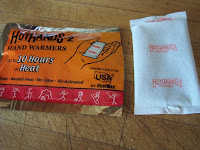(Click for larger image)
Lesson: Exothermic reactions produce heat
What Happened: Iron powder began oxidizing (rusting) when exposed to the air, becoming hot
As soon as I poured the powder into the mason jar, it started to heat up. I don't know how hot it got (Note to self: Get thermometer!) but I suspect it was hotter than the temperatures listed above, because it didn't last as long. Probably because it was exposed to more air than if I had left it in the air-permeable packet. It may have dried out quicker, too.Lesson: Exothermic reactions produce heat
What Happened: Iron powder began oxidizing (rusting) when exposed to the air, becoming hot
Although you can't see it in the picture at the top, there was smoke coming out of the jar. We also tried mixing some with a little more water to see what happened. The heating process stopped. However, when I dipped a magnet into the resulting goop it did act a little like ferrofluid.
What's going on (from Camping Survival):
The heating process takes place in this fashion:And the chemical equation (from Curriki, which tells you how to mix up your own):
- The iron in the pouch, when exposed to oxygen, oxidizes and therefore produces heat (aka, "Air Activated").
- When iron oxidizes it produces iron oxide, more commonly referred to as rust.
- The salt acts as a catalyst.

- The carbon [activated charcoal] helps disperse the heat.
- The vermiculite [the shiny mica-like specks] acts as an insulator for the purpose of retaining the heat and the cellulose is added as a filler.
- All of these ingredients are surrounded by a polypropylene bag.
- Polypropylene allows air to permeate the ingredients while holding in moisture.
Hand warmers work because of a rusting process. The rusting is a redox reaction and the equation is as follows: 4Fe(s) + 3O2(g) -> 2Fe2O3(s) .





9 comments:
I'm a ski patroller, and our standard treatment for cold injuries like hypothermia and frostbite is warming (duh) and oxygen.
What if you're warming a patient with handwarmers and the O2 concentration gets a little high?
In a word: Nothing. At least, not if you leave the handwarmer intact. I tried bathing one in a direct stream of 100% O2 (15 L/min flow rate), and it didn't even get noticeably hotter.
Though I wonder what happens if you enclose it, or rip the envelope...
I wonder what would happen if you mixed a teaspoon of hydrogen peroxide to the powder.
Is there any way to increase this reaction? Catalysts etc?
lupus, there are other elements with in the air we breath and all of those help to react with the elements inside the hand warmers to create the heat, and there is a natural catalyst with in the hand warmer its the NaCl (table salt)
do you have to use hand warmers????
can you use feeet or toe warmers??
How do the manufacturers keep them from instantly heating before they package the warmers? Do they mix the ingredients and package them in a vacuum system to keep the air from getting to them? Just curious
I wonder what would happen if you mix uranium with it.
Powdered metals of several kinds (including iron and aluminum) are known to "combust" when exposed to air. If you add a chemical oxidizer: watch out! It's very dangerous to accelerate the oxidation process.
aluminum powder is added to certain explosive to "enhance" them. (It's an important ingreadiant in flash powder). Iron powder is known to have been used in mixing solid rocket propellants.
How do the hanwarmers that you shake heat
Post a Comment